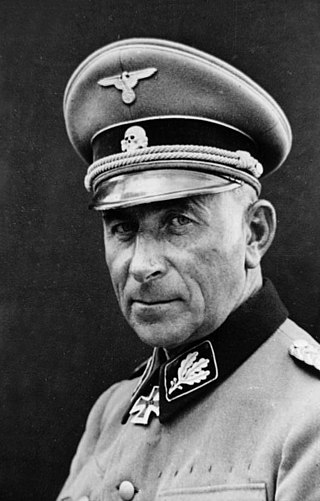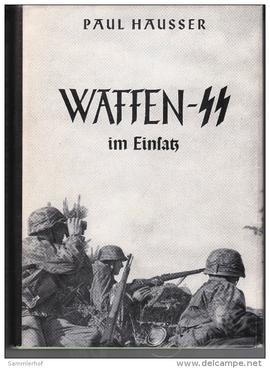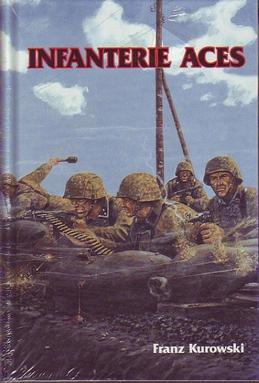Related Research Articles

The Waffen-SS was the combat branch of the Nazi Party's paramilitary Schutzstaffel (SS) organisation. Its formations included men from Nazi Germany, along with volunteers and conscripts from both German-occupied Europe and unoccupied lands. It was disbanded in May 1945.

Joachim Peiper was a German Schutzstaffel (SS) officer and war criminal convicted for the Malmedy massacre of U.S. Army prisoners of war (POWs). During the Second World War in Europe, Peiper served as personal adjutant to Heinrich Himmler, leader of the SS, and as a tank commander in the Waffen-SS. German historian Jens Westemeier writes that Peiper personified Nazi ideology, as a purportedly ruthless glory-hound commander who was indifferent to the combat casualties of Battle Group Peiper, and who encouraged, expected, and tolerated war crimes by his Waffen-SS soldiers.

Paul Hausser also known as Paul Falk after taking his maiden name post war was a German general and then a high-ranking commander in the Waffen-SS who played a key role in the post-war efforts by former members of the Waffen-SS to achieve historical and legal rehabilitation.

Friedrich von Mellenthin was a German general during World War II. A participant in most of the major campaigns of the war, he became known afterwards for his memoirs Panzer Battles, first published in 1956 and reprinted several times since then.

Kurt Meyer was an SS commander and convicted war criminal of Nazi Germany. He served in the Waffen-SS and participated in the Battle of France, Operation Barbarossa, and other engagements during World War II. Meyer commanded the 12th SS Panzer Division Hitlerjugend during the Allied invasion of Normandy, and was a recipient of the Knight's Cross of the Iron Cross with Oak Leaves and Swords.

Panzer Battles is the English language title of Friedrich von Mellenthin's memoirs of his service as a staff officer in the Panzerwaffe of the German Army during World War II.

Herbert Otto Gille was a high-ranking German SS officer, and divisional & corps commander of the Waffen SS. He commanded the SS Division Wiking during World War II. Gille was a recipient of the Knight's Cross of the Iron Cross with Oak Leaves, Swords and Diamonds, making him the most highly decorated Waffen-SS member of the war. After the war, Gille opened a book store and became active in HIAG, a lobby group and a revisionist veteran's organisation founded by former high-ranking Waffen-SS personnel in West Germany in 1951.
HIAG was a lobby group and a denialist veterans' organisation founded by former high-ranking Waffen-SS personnel in West Germany in 1951. Its main objective was to achieve legal, economic, and historical rehabilitation of the Waffen-SS.
Walter Harzer was a German SS commander during the Nazi era. He commanded the SS Division Hohenstaufen and SS Polizei Division.
The Himmerod memorandum was a 40-page document produced in 1950 after a secret meeting of former Wehrmacht high-ranking officers invited by Chancellor Konrad Adenauer to the Himmerod Abbey to discuss West Germany's Wiederbewaffnung (rearmament). The resulting document laid the foundation for the establishment of the new military force (Bundeswehr) of the Federal Republic.

Franz Kurowski was a German author of fiction and non-fiction who specialised in World War II topics. He is best known for producing apologist, revisionist and semi-fictional works on the history of the war, including the popular English-language series Panzer Aces and Infantry Aces.

The Myth of the Eastern Front: The Nazi–Soviet War in American Popular Culture (2008) by Ronald Smelser and Edward J. Davies, is a historical analysis of the post-war myth of the "Clean Wehrmacht", the negative impact of the Wehrmacht and the Waffen-SS mythologies in popular culture, and the effects of historical negationism upon cultural perceptions of the Eastern Front of the Second World War.

Waffen-SS im Einsatz is a 1953 book in German by Paul Hausser, a former high-ranking SS commander and a leader of the Waffen-SS lobby group HIAG. As part of the organisation's historical-negationist agenda, it advanced the idea of the purely military role of the Waffen-SS.

Panzer Aces is an English-language book series by the German author Franz Kurowski. Originally released in 1992 by J.J. Fedorowicz Publishing, a Canadian publisher of military literature, it was licensed in 2002 by the firm to American publishers Ballantine Books and Stackpole Books. The series' books were a commercial success and enjoyed a wide readership among the American public.
J.J. Fedorowicz Publishing is a Canadian publishing house that specialises in literature on the German armed forces of the World War II era. Its authors are both popular history writers such as Paul Carell and Franz Kurowski, along with the war-time veterans, including Kurt Meyer of the SS Division Hitlerjugend and Otto Weidinger of the SS Division Das Reich.
Ernst Klink was a German military historian who specialised in Nazi Germany and World War II. He was a long-term employee at the Military History Research Office (MGFA). As a contributor to the seminal work Germany and the Second World War from MGFA, Klink was the first to identify the independent planning by the German Army High Command for Operation Barbarossa.
Ernst-Günther Krätschmer was a German SS-officer. After World War II he took part in efforts to shape a positive image of the Waffen-SS in popular culture. He published about the Knight's Cross recipients of the Waffen-SS, contributed to the publications of the HIAG, the revisionist veterans' organisation of the Waffen-SS, and organized support for Walter Reder, who was being imprisoned in Italy for war crimes

Infantry Aces is an English-language book by the German author Franz Kurowski. Originally released by the Canadian publisher of militaria literature J.J. Fedorowicz Publishing, it was later licensed by Fedorowicz to the American publishers Ballantine Books and Stackpole Books. The book was a commercial success and enjoyed a wide readership among the American public.
Waffen-SS veterans in post-war Germany played a large role, through publications and political pressure, in the efforts to rehabilitate the reputation of the Waffen-SS, which had committed numerous war crimes during World War II. High ranking German politicians courted former Waffen-SS members and their veteran organisation, HIAG. A small number of veterans, somewhat controversially, served in the new German armed forces, the Bundeswehr.
Mark C. Yerger was an American author of books about the Schutzstaffel (SS) and Waffen-SS of Nazi Germany. He had close contacts to SS veterans, through whom he was able to access private archives, and wrote biographies of commanders and award recipients of the SS and of SS units. Historians of World War II have described Yerger's work as uncritical, hagiographic and whitewashing towards the SS.
References
Notes
- ↑ See the chapter "Tarnished Shield: Waffen-SS Criminality" in The Waffen SS: Hitler's Elite Guard at War, 1939–1945 (1966) by George H. Stein
- ↑ According to Large, HIAG attempted "to manipulate historical record or simply to ignore it". [10]
- ↑ According to Parker, "the way the old comrades wanted it remembered". [20]
- ↑ Danny Parker calls the pamphlet an "exculpatory manifesto" and writes: "The literary subversion worked. Now the SS veterans moved themselves from the prosecutors to the prosecuted!" [20]
- ↑ Smelser and Davies: "Unfortunately, the scholarly writings remained confined to a small audience, whereas the readership of the German authors (and their English-language spin-offs) was considerably larger". The authors write that "with a forty-year head start", the predominance of the German account, and the related fascination by Waffen-SS romancers, "hardly remains a mystery". [30]
Citations
- ↑ Stein 1984, pp. xxiv, xxv, 150, 153.
- ↑ Neitzel & Welzer 2012, p. 290.
- ↑ Longerich 2010, p. 185.
- ↑ Longerich 2012, p. 470.
- ↑ Hart 2015, p. 115.
- ↑ Bartrop & Jacobs 2014, p. 1424.
- ↑ Stein 1984, pp. 250–251.
- 1 2 MacKenzie 1997, p. 138.
- 1 2 Wilke 2011, p. 399.
- 1 2 Large 1987, p. 81.
- 1 2 Wegner 1990, p. 1.
- 1 2 Smelser & Davies 2008, pp. 135–136.
- ↑ MacKenzie 1997, pp. 137–138.
- ↑ Tauber Volume I 1967, p. 539.
- ↑ Stein 1984, p. 256.
- ↑ Sydnor 1973.
- ↑ Sydnor 1990, p. 145.
- 1 2 Parker 2014, p. 215.
- ↑ Echternkamp 2015.
- 1 2 3 4 Parker 2014, p. 217.
- ↑ Parker 2014, p. 217, 390.
- ↑ Wienand 2015, p. 39.
- 1 2 MacKenzie 1997, p. 137.
- ↑ Steiner 1975, p. 96.
- ↑ Wilke 2011, pp. 379, 405.
- 1 2 Picaper 2014.
- ↑ Large 1987, pp. 111–112.
- ↑ Stein 1984, p. 252.
- ↑ Diehl 1993, p. 225.
- ↑ Smelser & Davies 2008, p. 136.
- ↑ Smelser & Davies 2008, p. 135.
- ↑ Antifa-Infoblatt 2001.
- ↑ Werther & Hurd 2014, pp. 332, 339.
- 1 2 Werther & Hurd 2014.
- ↑ MacKenzie 1997, p. 139.
- ↑ Pontolillo 2010.
- ↑ Parker 2014.
- ↑ Raudvere, Stala & Willert 2012, p. 112.
- ↑ MacKenzie 1997, p. 140.
- ↑ MacKenzie 1997, p. 141.
- ↑ Smelser & Davies 2008, p. 159.
- ↑ Smelser & Davies 2008, pp. 159–161.
- ↑ Smelser & Davies 2008, pp. 173–178, 251.
- ↑ Smelser & Davies 2008, pp. 211, 284.
- ↑ Smelser & Davies 2008, p. 207.
- ↑ Smelser & Davies 2008, pp. 181–185.
- ↑ Pieper 2015, pp. 8, 191.
- ↑ Citino 2012, p. 322.
- ↑ Smelser & Davies 2008, pp. 187–188.
- ↑ Wildermuth 2016.
- ↑ Smelser & Davies 2008, pp. 201–205.
- ↑ Smelser & Davies 2008, pp. 206–218.
- ↑ Smelser & Davies 2008, p. 226.
- 1 2 Green 2010.
Bibliography
Books
- Hart, Russell A. (2015). Crenshaw, Martha; John, Pimlott (eds.). International Encyclopedia of Terrorism. Routledge. ISBN 978-1135919665.
- Bartrop, Paul R.; Jacobs, Leonard, eds. (2014). Modern Genocide: The Definitive Resource and Document Collection. Vol. 1. Santa Barbara, Calif.: ABC-CLIO. ISBN 978-1-61069-363-9.
- Citino, Robert M. (2012). The Wehrmacht Retreats: Fighting a Lost War, 1943. Lawrence, KS: University Press of Kansas. ISBN 978-0-7006-1826-2. Archived from the original on 2016-10-07. Retrieved 2016-04-20.
- Diehl, James M. (1993). Thanks of the Fatherland: German Veterans After the Second World War. Chapel Hill: University of North Carolina Press. ISBN 978-0-8078-2077-3. Archived from the original on 2016-11-23. Retrieved 2016-04-17.
- Longerich, Peter (2010). Holocaust: The Nazi Persecution and Murder of the Jews. Oxford; New York: Oxford University Press. ISBN 978-0-19-280436-5.
- Longerich, Peter (2012). Heinrich Himmler: A Life. Oxford; New York: Oxford University Press. ISBN 978-0-19-959232-6.
- MacKenzie, S.P. (1997). Revolutionary Armies in the Modern Era: A Revisionist Approach. New York: Routledge. ISBN 978-0-415-09690-4.
- Neitzel, Sönke; Welzer, Harald (2012). Soldaten: On Fighting, Killing and Dying. Simon and Schuster. ISBN 978-1-84983-949-5.
- Parker, Danny S. (2014). Hitler's Warrior: The Life and Wars of SS Colonel Jochen Peiper. Boston: Da Capo Press. ISBN 978-0-306-82154-7. Archived from the original on 2017-06-29. Retrieved 2016-04-17.
- Picaper, Jean-Paul (2014). Les Ombres d'Oradour: 10 Juin 1944[The Shadows of Oradour: 10 June 1944] (in French). Paris: Éditions l'Archipel. ISBN 978-2-8098-1467-5.
- Pieper, Henning (2015). Fegelein's Horsemen and Genocidal Warfare: The SS Cavalry Brigade in the Soviet Union. Houndmills, Basingstoke, Hampshire: Palgrave Macmillan. ISBN 978-1-137-45631-1.
- Pontolillo, James (2010). Murderous Elite: The Waffen-SS and Its Record of Atrocities. Stockholm: Leandoer and Ekholm. ISBN 978-91-85657-02-5.
- Raudvere, Catharina; Stala, Krzysztof; Willert, Trine Stauning (2012). Rethinking the Space for Religion: New Actors in Central and Southeast Europe on Religion, Authenticity and Belonging. Lund: Nordic Academic Press. ISBN 978-91-87121-85-2.
- Smelser, Ronald; Davies, Edward J. (2008). The Myth of the Eastern Front: The Nazi-Soviet War in American Popular Culture. New York: Cambridge University Press. ISBN 978-0-521-83365-3.
- Stein, George (1984) [1966]. The Waffen-SS: Hitler's Elite Guard at War 1939–1945 . Ithaca, N.Y.: Cornell University Press. ISBN 978-0-8014-9275-4.
- Steiner, John Michael (1975). Power Politics and Social Change in National Socialist Germany: A Process of Escalation Into Mass Destruction. The Hague: De Gruyter Mouton. ISBN 978-90-279-7651-2.
- Sydnor, Charles W. (1990) [1977]. Soldiers of Destruction: The SS Death's Head Division, 1933–1945. Princeton, N.J.: Princeton University Press. ISBN 978-0-691-00853-0.
- Tauber, Kurt (1967). Beyond Eagle and Swastika: German Nationalism Since 1945, Volume I. Middletown, Conn.: Wesleyan University Press.
- Wegner, Bernd (1990). The Waffen-SS: Organization, Ideology and Function. New York: Blackwell Publishers. ISBN 978-0-631-14073-3.
- Wienand, Christiane (2015). Returning Memories: Former Prisoners of War in Divided and Reunited Germany. Rochester, NY: Boydell & Brewer. ISBN 978-1-57113-904-7. JSTOR 10.7722/j.ctt13wzt4c.
- Wilke, Karsten (2011). Die "Hilfsgemeinschaft auf Gegenseitigkeit" (HIAG) 1950–1990: Veteranen der Waffen-SS in der Bundesrepublik[HIAG 1950–1990: Waffen-SS veterans in the Federal Republic] (in German). Paderborn: Schoeningh Ferdinand. ISBN 978-3-506-77235-0.
Journals
- Large, David C. (1987). "Reckoning without the Past: The HIAG of the Waffen-SS and the Politics of Rehabilitation in the Bonn Republic, 1950–1961". The Journal of Modern History. 59 (1). University of Chicago Press: 79–113. doi:10.1086/243161. JSTOR 1880378. S2CID 144592069.
- Sydnor, Charles W. (1973). "The History of the SS Totenkopfdivision and the Postwar Mythology of the Waffen SS". Central European History. 6 (4). Cambridge University Press: 339–362. doi:10.1017/S0008938900000960. S2CID 144835004.
- Werther, Steffen; Hurd, Madeleine (2014). "Go East Old Man: The Ritual Spaces of SS Veteran's Memory Work" (PDF). Culture Unbound. Journal of Current Cultural Research. 6 (2): 327–359. doi: 10.3384/cu.2000.1525.146327 . Archived from the original (PDF) on 2016-01-02.
Websites and periodicals
- "'Der Freiwillige': The next generation". Antifa-Infoblatt (in German). 2001. Retrieved 2015-12-08.
- Echternkamp, Jörg (2015). "Die Bundeswehr, das Verteidigungsministerium und die Aufarbeitung der NS-Vergangenheit im Systemkonflikt" [The Bundeswehr, the Ministry of Defense, and the revision of the Nazi past] (in German). Potsdam: Zeitgeschichte-online .
- Green, Joshua (8 October 2010). "Why Is This GOP House Candidate Dressed as a Nazi?". The Atlantic . Archived from the original on 2015-12-21. Retrieved 2015-12-20.
- Wildermuth, David (2016). "Mythbusters: Uncovering the Real Authors behind the Myth of the Eastern Front". H-Net . Retrieved 2016-12-02.